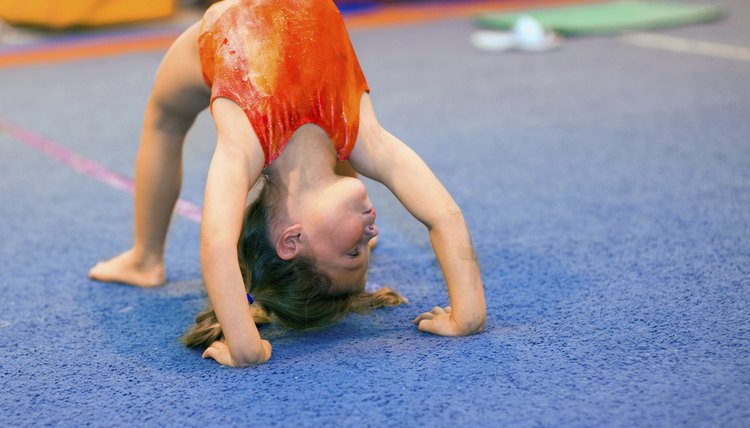What does fact checked mean?
At SportsRec, we strive to deliver objective content that is accurate and up-to-date. Our team periodically reviews articles in order to ensure content quality. The sources cited below consist of evidence from peer-reviewed journals, prominent medical organizations, academic associations, and government data.
- "Journal of Bone and Mineral Research"; Skeletal Benefits After Long-Term Retirement in Forme Eite Female Gymnasts; P. Eser, et al.; December 2009
- "Journal of Bone and Mineral Research"; Skeletal Benefits After Long-Term Retirement in Forme Eite Female Gymnasts; P. Eser, et al.; December 2009
- "Physical Therapy in Sport"; Acrobatic Gymnastics Injury: Occurrence, Site and Training Risk Factors; M. Purnell, et al.; May 2010
- "Physical Therapy in Sport"; Acrobatic Gymnastics Injury: Occurrence, Site and Training Risk Factors; M. Purnell, et al.; May 2010
- "Pediatrics"; Gymnastics-Related Injuries to Children Treated in Emergency Departments in the United States, 1990 - 2005; S. Singh, et al.; April 2008
- "Pediatrics"; Gymnastics-Related Injuries to Children Treated in Emergency Departments in the United States, 1990 - 2005; S. Singh, et al.; April 2008
The information contained on this site is for informational purposes only, and should not be used as a substitute for the advice of a professional health care provider. Please check with the appropriate physician regarding health questions and concerns. Although we strive to deliver accurate and up-to-date information, no guarantee to that effect is made.
Pros and Cons of Gymnastics

Gymnastics offers significant health benefits, even improving problem-solving skills. It improves bone density, flexibility, strength and coordination. Additionally, it can reduce stress. However, gymnastics also poses the risk of increased injury and adds pressure to remain thin. Before beginning gymnastics, or enrolling your child in the sport, weigh the pros and cons of gymnastics. If you choose to practice gymnastics, make sure to check the equipment and mats prior to starting any activities, thus decreasing the risk of injury.
Overall Benefits
Gymnastics offers a variety of benefits for the body and the mind. According to USA Gymnastics national safety instructor Michael A. Taylor and the University of Florida, children who participate in organized gymnastics classes have better problem-solving skills and longer attention spans than those who do not. For adults and teens, gymnastics increases coordination, flexibility and strength as well as reduces stress.
Skeletal Benefits
Elite female gymnasts who have been retired for six years or less and continue to exercise for two hours a week experience skeletal benefits compared to women in the general population, according to a study by Deakin University in Australia and published in the December 2009 issue of the “Journal of Bone and Mineral Research.” The gymnasts had significantly greater bone density of the radius, humerus, femur and tibia than the nongymnasts. They also had larger forearm and upper-arm muscles.
Injury Risk
Sustaining an injury is one of the cons of participating in acrobatic gymnastics, and participants between the ages of 11 and 15 are the most vulnerable, according to a study from the University of Sydney and published in the May 2010 issue of the journal “Physical Therapy in Sport.” In acrobatic gymnastics, the participants perform in pairs. Data from 73 surveys of acrobatic gymnasts found 50.7 percent experienced a gymnastics-related injury in the past year and 28.8 were afflicted with a chronic injury at the time of the study. Predominant injury sites were the knee, ankle and wrist. Risk factors increased if the gymnasts were age 13 or older, and if gymnasts trained eight or more hours a week at age 11.Gymnastics is one of the sports with the highest injury rates for girls, according to a study by Ohio State University and published in the April 2008 issue of “Pediatrics.” Between 1990 and 2005, about 425,900 boys and girls between ages 6 and 17 were treated in emergency rooms for gymnastics-related injuries in the United States. The likelihood of being injured while doing gymnastics is 4.8 percent per thousand gymnasts and those between the ages of 12 and 17 had the highest rate of injury at 7.4 percent per 1,000 gymnasts.
Pressure to Diet and Eating Disorders
Extreme dieting can be a serious hazard to young girls and the pressure to stay small in gymnastics can lead to eating disorders and stunted growth. It can also have lasting, psychological affects on preteen and teen girls. In a NCAA study performed among gymnastics programs, 51% reported team members with eating disorders.
References
- "Journal of Bone and Mineral Research"; Skeletal Benefits After Long-Term Retirement in Forme Eite Female Gymnasts; P. Eser, et al.; December 2009
- "Physical Therapy in Sport"; Acrobatic Gymnastics Injury: Occurrence, Site and Training Risk Factors; M. Purnell, et al.; May 2010
- "Pediatrics"; Gymnastics-Related Injuries to Children Treated in Emergency Departments in the United States, 1990 - 2005; S. Singh, et al.; April 2008
- American Academy of Orthopaedic Surgeons; Gymnastics Injury Prevention; 2009
- Eating Disorder Hope: Girls Gymnastics: When a Bright Spotlight Casts a Dark Shadow
Writer Bio
Victoria Weinblatt began writing articles in 2007, contributing to The Huffington Post and other websites. She is a certified yoga instructor, group fitness instructor and massage therapist. Weinblatt received her B.S. in natural resources from Michigan State University and an M.Ed. from Shenandoah University.
